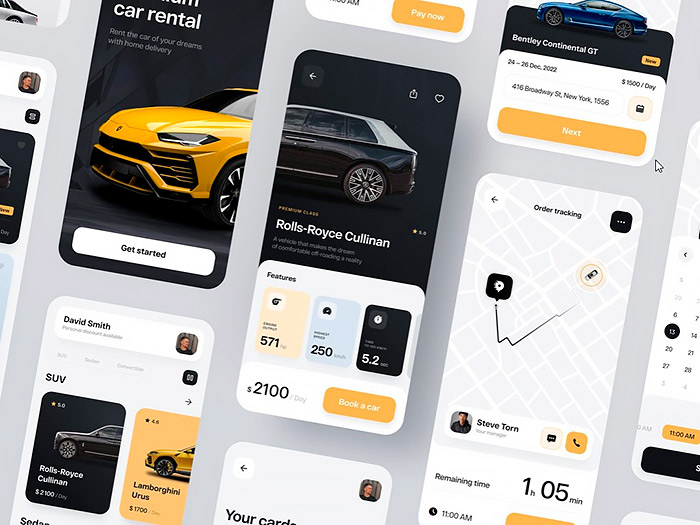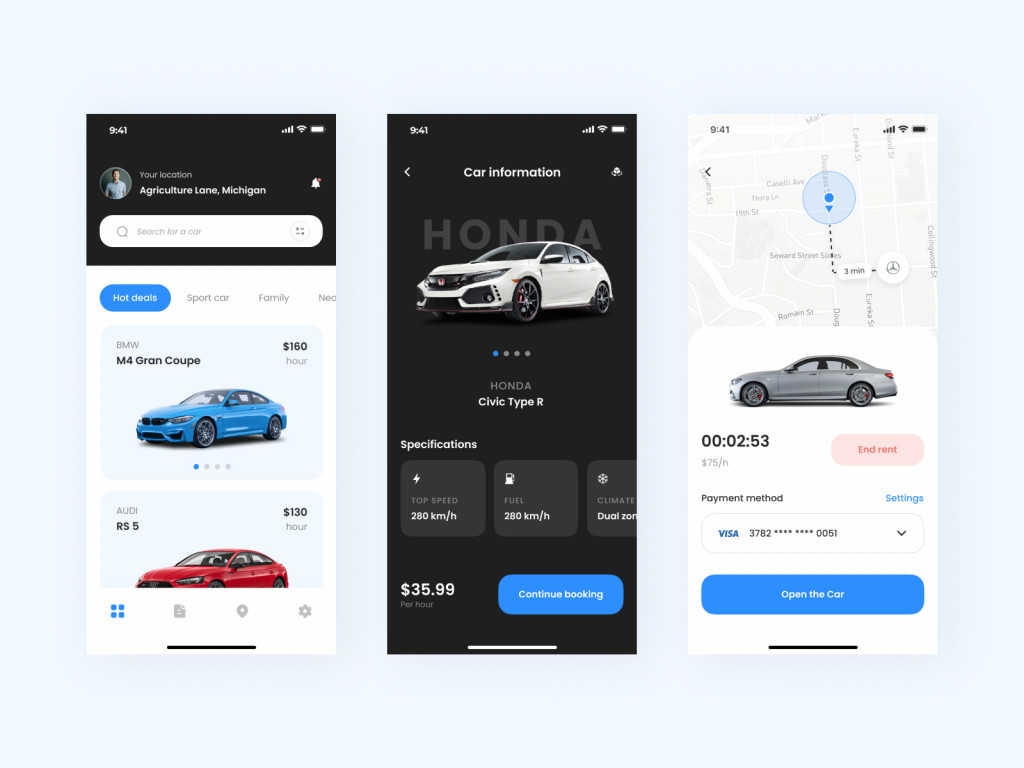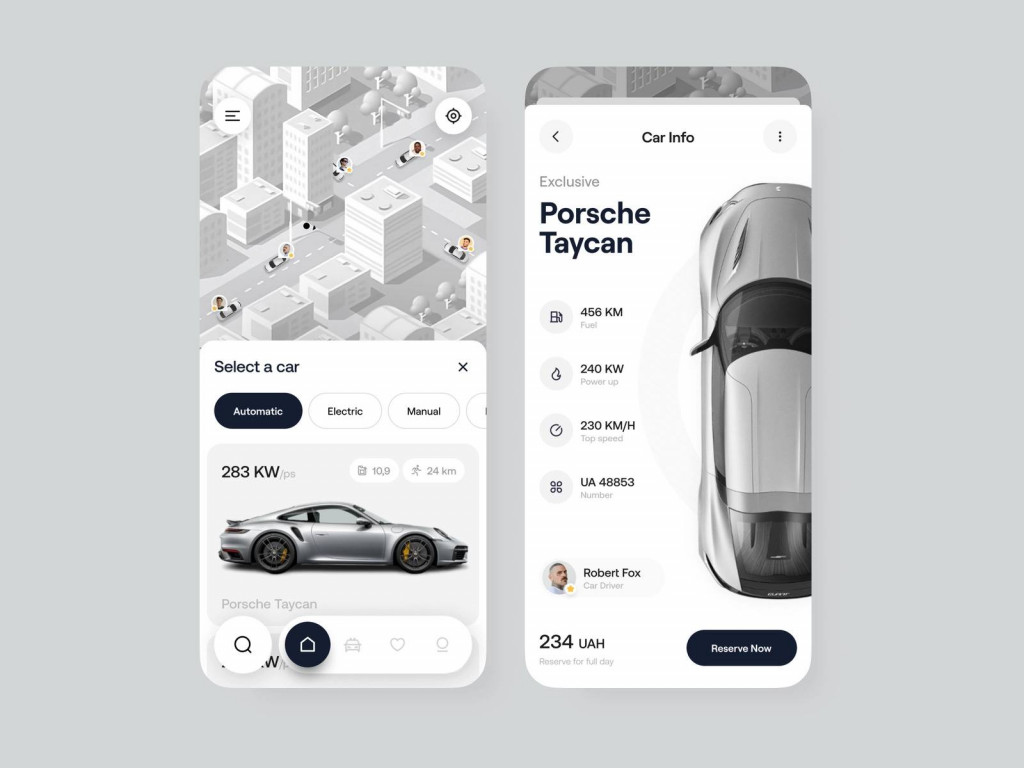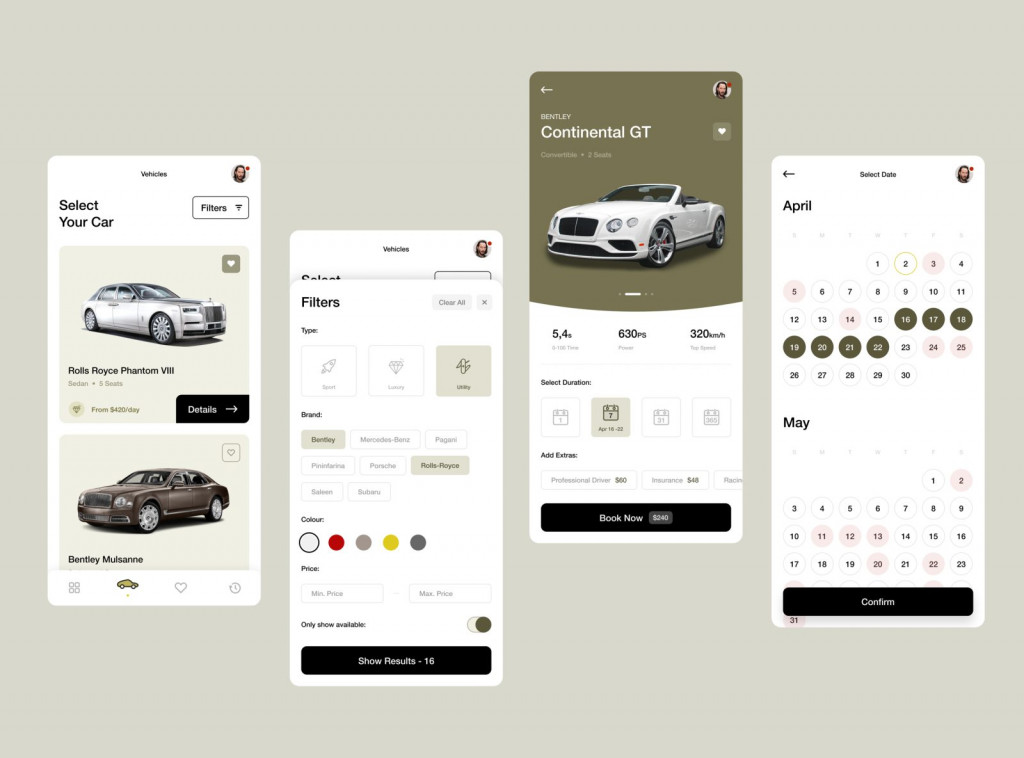How to burst into the market if you are a small business or a startup? The best way is to pick a vital role for your product to make it more demanded among the target audience. In today’s digital age, the car rental industry is undergoing a significant transformation with the rise of mobile applications. So developing a car rental app can provide you with a competitive edge and open up new revenue streams.
Contents:
Here are some statistics. By 2031, the worldwide automobile rental industry might nearly treble to $121.1 billion. The average daily price has risen by 76%, reaching 278% in key tourist spots. Are you still hesitating about diving into this sphere?
Let’s explore the process of creating a car rental app even with a small budget, enabling you to leverage all the benefits while keeping costs in check.
What is a car rental app
It is a mobile application that enables users to rent vehicles conveniently and efficiently through their smartphones. They streamline the rental process by providing features such as vehicle selection, booking, payment, and navigation.
What are the benefits of investing in such a project?
- Increased reach: it expands your customer base by reaching a wider audience, allowing you to tap into the growing market of smartphone users;
- Enhanced user experience: you can provide a convenient interface, enabling customers to book and manage their rentals effortlessly;
- Cost savings: if you already have a rental business, automating the process through an app reduces your own operational costs, including paperwork and manual processes;
- Competitive advantage: having dedicated app positions your business as innovative and forward-thinking, differentiating it from competitors;
- Business insights: data analytics within the application can offer valuable insights into customer preferences, allowing you to make data-driven decisions.

Car rental app by Conceptzilla
What features are essential for a car rental mobile app?
When designing a product, you need to be careful in selecting options available to the clients. There are several options that can be considered essential or non-essential based on their importance and impact on the user experience.
Essential features:
- User registration and authentication: allow users to create accounts, log in securely, and manage their personal information.
- Car search and filtering: people would like to search for available cars based on criteria such as location, date, time, vehicle type, and price range.
- Booking and reservation: sometimes clients need a ride at a certain time. So let them specify the rental duration, and make a reservation. Provide confirmation details and booking history.
- Pricing and payment integration: display transparent pricing information, including rental rates, additional charges, and taxes. Integrate secure payment options, such as credit card, PayPal or digital wallet integration.
- Vehicle details and media: your clients will not wander around searching for the arrived driver, if you give them comprehensive information about each car, including photos, descriptions, features, and specifications.
- Availability and real-time updates: show the availability of cars in real-time, allowing users to see which vehicles are currently available for rental.
- Booking management: people need to modify or cancel their reservations, view upcoming and past bookings, and access related details.
- Navigation and maps integration: add maps and GPS functionality to provide directions to rental car pick-up and drop-off locations.
- Push notifications: send notifications to users regarding booking confirmations, updates, payment reminders, and other important information.
- Customer support: include options for people to contact customer support via phone, email, or in-app chat for assistance with queries, issues, or emergencies.
Non-essential features:
- Car reviews and ratings: to control the service quality, allow users to rate and review their rental experience, providing feedback to other potential customers.
- Trip itinerary and navigation: integrate trip planning features, including suggested itineraries and points of interest, along with navigation assistance during the rental period.
- Driver verification: security is crucial for such projects, so offer drivers to verify and validate their license or the identity of the person renting the car. Suggest additional rewards for undergoing this procedure, for example, special icons, badges, or discounts.
- Advanced filtering and sorting: provide additional filters or sorting options to refine search results, such as fuel type, transmission, or specific car models.
- Loyalty programs: implement a loyalty program to reward frequent renters with discounts, perks, or special offers.
- Social media integration: for more feedback, allow users to share their rental experiences on social media platforms.
It’s important to note that features prioritization may vary based on the specific target audience, market, and business requirements of the car rental app. Conducting user research and gathering feedback can help sort features and align them with the needs and expectations of the clients.

Car Rental Mobile App by Artiom Larin
How to create a car rental app with a small budget
Step 1: Research and planning
Thorough market research and competitive analysis are vital to understanding customer needs, identifying market gaps, and discovering unique selling propositions. So before rushing into the actual development, gather insights on pricing, app monetization, features, and customer expectations to tailor your app accordingly.
Releasing an all-round versatile application is tempting, however, with a limited budget, it’s better to opt for a minimum viable product (MVP). This version includes the most essential features and functionalities that allow it to be tested by users. An MVP development gives the team the ability to quickly launch a product, receive feedback on its features, and make necessary changes before releasing a fully functional version. In the case of a car renting app, prioritize essential features such as vehicle selection, booking, payment gateway integration, GPS tracking, and customer support. Consider options like push notifications, reviews and ratings, and loyalty programs for future iterations.
Step 2: Design and development
After careful business planning, it’s time to select the technical toolkit and target platforms. Of course, the easiest way is to find a professional development team first. They will recommend you the latest technologies to implement into the project, as well as point out possible issues. Together, you can evaluate the pros and cons of different platforms and stacks to select the most suitable options for your target audience. Most teams consider cross-platform development frameworks like React Native or Flutter to save costs while targeting both iOS and Android platforms. Adopt an Agile development methodology to efficiently build your car rental app within a small budget. Divide the process into sprints, focusing on core functionalities first and gradually adding new features.
As for the design, keep it simple. Your clients and drivers likely won’t have time to figure out fancy UI. Focus on creating a user-friendly interface with intuitive navigation, clear call-to-action buttons, and a visually appealing look. Prioritize the user experience (UX) by keeping the app simple, responsive, and easy to use. Soft colors, rounded fonts, convenient 3D map with geolocation and search, and non-distracting animations — that’s all you need.
Step 3: Testing and launching
Since people will run your application on different devices and configurations, you need to thoroughly test it to ensure a seamless user experience. Conduct extensive quality assurance (QA) testing, including beta testing, performance testing, and usability testing, to identify and fix any bugs or issues. Don’t forget to run the app on different screen sizes and check whether everything is positioned correctly.
Once testing is mostly done, it’s time to release your product. However, no need to hurry: there are strict guidelines and rules to follow. Without ASO (App Store Optimization) you won’t get far. It is a process of optimizing mobile apps to improve their visibility and ranking in the app stores, such as Google Play and the App Store. It involves optimizing elements such as the title, descriptions, keywords, and other metadata to improve the app’s visibility. ASO can also involve techniques such as link building and ratings or reviews to improve the app’s ranking.

Car Rental App by Sajon
Step 4: Promote and maintain
Promoting and maintaining your mobile application after its release is crucial for its success and continued growth. Here are some key strategies you can implement:
- Social Media Marketing: leverage popular social media platforms to create a strong online presence for your app. Share engaging content, updates, and announcements to attract and engage users. Run targeted ad campaigns to reach your desired audience.
- Content marketing: create a blog or website to provide valuable content related to your app’s niche or industry. Publish informative articles, tutorials, and case studies to establish yourself as an expert and drive traffic to your app.
- Influencer marketing: collaborate with influencers or bloggers who have a strong following in your app’s target audience. They can review or promote your app to their followers, increasing the visibility and credibility of your brand.
- User reviews and ratings: encourage users to leave feedback on the app stores. Positive reviews and high ratings enhance your app’s reputation and attract more downloads. Respond promptly and professionally to both positive and negative reviews.
- Regular updates: continuously improve your product by adding new features, fixing bugs, and addressing user feedback. This attitude demonstrates your commitment to providing a quality user experience and can lead to increased user engagement and positive reviews.
- In-app analytics: implement analytics tools to track user behavior, identify popular features, and understand user preferences. This data will help you make informed decisions regarding updates, improvements, and targeted marketing campaigns.
- App performance optimization: ensure your app is optimized for speed, stability, and efficiency. Regularly test your app on different devices and operating systems to identify and address any performance issues.
- User engagement and retention: implement strategies to keep users engaged and encourage long-term usage. This can include sending push notifications, offering personalized recommendations, running loyalty programs, and providing exclusive content or discounts.
- Customer support: Offer reliable support channels such as email, chat, or a dedicated support portal. Promptly address user queries, concerns, and issues to enhance user satisfaction and maintain a positive reputation.
Remember, promoting and maintaining your mobile application is an ongoing process. Continuously monitor user feedback, adapt your strategies, and stay up to date with industry trends to ensure your project remains relevant and successful.
Costs
Creating a car renting application involves various costs, which can be categorized into different areas.
Development
- App design & development: this includes the expenses related to hiring developers, designers, and testers to build the product, create the user interface, implement backend functionalities, and ensure overall quality. By hiring an outsourced team, you might possibly save expenses by up to 50%. In general, the average hourly rate for services is $40-45 for development and $70-80 for design. So, an app with registration, admin panels, geolocation, and other essential issues will cost approximately 400+ hours (~$50 000) or 1140+ hours (~$142 500) for a custom approach. To get an average cost for your product, use a project cost calculator.
- Technologies & tools: these are expenses associated with acquiring licenses for software, frameworks, libraries, databases, cloud hosting services, and other necessary tools to support the development process.
- Third-party integrations: if you plan to integrate third-party services like payment gateways, location services, SMS notification, or vehicle tracking systems, you may include additional costs for licenses or usage fees into your car renting application.

Luxury Vehicle Renting App by Rok Premuz
Infrastructure
- Hosting and server expenses: you will have to plan expenses for hosting the app on cloud services like Amazon Web Services (AWS), Microsoft Azure, or Google Cloud Platform. The prices depend on factors such as server specifications, data storage, bandwidth, and scalability requirements.
- Database management: to store all the information, you will need databases. So be sure to include costs for setting up and managing the database system, as well as backups, security measures, and any necessary maintenance.
Security
- Data protection: invest in security measures during mobile app development to protect user data, including encryption, secure transmission protocols (HTTPS), firewalls, and regular audits to ensure the project is safeguarded against potential threats.
- Payment security: in addition to standard measures, consider implementing secure gateways and adhering to relevant compliance standards like Payment Card Industry Data Security Standard (PCI DSS) to protect users’ financial information.
Maintenance and updates
- Bug fixes: it’s hard to polish the project right on the release, so include regular maintenance costs to address any software bugs, fix issues, and continuous improvements.
- Operating system updates: apart from your enhancements, keep in mind that the device’s OS changes as well. Give regular updates to remain compatible with the latest versions of mobile systems and devices.
- Feature updates: think about adding new features, integrating user feedback, and adapting to evolving market trends to ensure the car renting application remains competitive.
Possible issues and challenges to consider
- Scope creep: be cautious of feature creep or expanding the scope beyond the initial plan, as it can lead to increased development time and costs.
- Third-party integration issues: adding external services can sometimes be complex, requiring extra effort and potential expenses.
- User experience (UX) optimization: ensuring a smooth and intuitive experience may require iterations, which can affect timelines and costs.
- Regulatory compliance: depending on the jurisdiction, you may need to comply with specific legal requirements and regulations related to car rental services, data protection, or payment processing.
- Remember, cost estimation is a crucial step in planning your project. Allocate a contingency budget to account for any unexpected expenses that may arise during the development process. Regularly review and adjust your budget as the project progresses to ensure financial viability.
Conclusion
Creating a car rental app on a small budget requires careful planning, strategic prioritization, and efficient execution. Begin with thorough market research, determine essential features, select the right platform and development team, design a user-friendly interface, test rigorously, and optimize app store presence. Then promote the app effectively, analyze data, and continuously improve based on user feedback.
Even if you are a startup or small business with a small budget, it is an achievable goal. Remember to focus on delivering a seamless user experience, making features prioritization, and maintaining a customer-centric approach throughout the development and maintenance phases. By leveraging the benefits of mobile app technology, you can really revolutionize the car rental industry and drive your business forward.
Want to create a versatile car renting app to burst into the market? Contact us and together we will build a product that is demanded by users and solves their pains.
